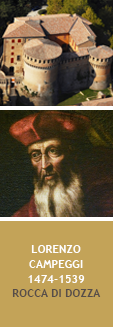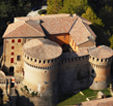Museum of Rocca di Dozza - (Bo)
Lorenzo Campeggi was an Italian cardinal, Catholic bishop and diplomat in the service of the Papal States. Born in Milan on 7 November 1474 to Giovanni Zaccaria Campeggi and Dorotea Tebaldi, Lorenzo was the first of five brothers. He studied in Pavia and Padua, and then obtained a doctorate in utroque iure in Bologna. In 1500 he married Francesca Guastavillani, with whom he had five children, three boys and two girls. Widowed in 1510, he decided to embrace an ecclesiastical career, becoming one of the most valid champions of the Catholic Church of that period. In 1511 Pope Julius II appointed him auditor of the Sacra Rota and, later, entrusted him with an extremely important mission: the nunciature to the Emperor Maximilian I. Returning to his homeland the following year, he was appointed Bishop of Feltre and obtained delicate diplomatic posts. which he conducted with the prudence and skill that distinguished him. In 1513 he went to Germany for the second time, where he remained for four years, obtaining so much esteem from the emperor that Maximilian I recommended him to the Pope for the dignity of cardinal, which Leo X welcomed in 1517. Later , Lorenzo was sent to England to Henry VIII: here too Campeggi managed to win the respect and sympathy of the English sovereign, who gave him the palace of the English ambassadors in Rome, six thousand gold scudi, ten stupendous horses, precious pottery and moreover, he had him nominated by the Pope Bishop of Salisbury. Not satisfied with this, in 1523 Henry VIII also appointed him cardinal protector of England.
Returning to Rome in that year, Lorenzo was declared Bishop of Bologna and, in January 1524, as legate for Germany, Hungary and Bohemia, made a long diplomatic trip to various cities to try to stem the Lutheran heresy and promote religious pacification. In 1527, during the Sack of Rome, Clement VII delegated some distinguished cardinals, including Lorenzo Campeggi, to deal with the invaders. Furthermore, the following year Lorenzo was sent back to Henry VIII by the Pope, with the arduous task of dissuading the English sovereign from dissolving his marriage with Catherine of Aragon in favor of Anna Bolena, an undertaking that did not go to fruition despite his valiant mediation efforts. Back in Italy, Lorenzo welcomed Charles V to Bologna, where he attended the ceremony for his coronation together with Clement VII, which took place on 24 February 1530 in the Basilica of San Petronio. Later, the Emperor himself wanted him by his side as papal legate to the Diet of Augusta, the most important legation of the entire life of the Campeggi. Due to his precarious health conditions, the now over sixtyyear- old Cardinal no longer took up diplomatic posts, but opened the ecumenical council convened in Vicenza in 1538. After returning to Rome, he died there on July 19, 1539.
In exchange for an entire existence in the service of the Church, Cardinal Lorenzo Campeggi obtained the fiefdom of Dozza from the Pope in 1529: on the one hand, the pontiff intended to reward Campeggi for the countless efforts and brilliant victories achieved in favor of the Holy See, from The other was indebted to him for four thousand gold ducats, which the Apostolic Chamber was unable to satisfy due to the consequences of the Sack of Rome a few years earlier. Lorenzo Campeggi was a distinguished diplomat and politician of 16th century Italy, a man of high values and great talents. Thanks to its enterprises, the Castle of Dozza became part of the possessions of the noble Campeggi family, becoming its prestigious residence, as well as feudal representative office, from 1529 to 1960.
CASTLE OF DOZZA
Lying on the crest of a hill overlooking the valley of the Sellustra river and gently sloping down towards the Via Emilia between Imola and Bologna, Dozza is a small ancient village with a millenary history and a still well-preserved medieval urban layout. The historic center of Dozza, with its characteristic spindle shape, is made up of narrow and colorful streets that rise upwards to the Castle. The integrity of the original building fabric has been safeguarded and the close symbiosis between the majestic Rocca at the top of the town and the residential settlement below communicates the harmony between nature and human intervention.
The Castle of Dozza, also known as Rocca Sforzesca of Dozza, is a complex building with a centuries-old history, which from the time of its construction, which can be placed around the mid-thirteenth century, has undergone numerous expansion and functional adaptation interventions, attributable to three main phases, still clearly visible within the museum visit itinerary. The fortress was inhabited until 1960, when it was sold to the Municipality of Dozza,
which opened it to the public as a house-museum. The museum is managed by Fondazione Dozza Città d'Arte and since 2006 has been recognized as a "Museum of Quality" by the Emilia-Romagna Region, Institute for Cultural and Natural Artistic Heritage.
MEDIEVAL AND RENAISSANCE FORTRESS
The Castle of Dozza was built around 1250 by the will of the Municipality of Bologna and, later, it was considerably modified and enlarged to meet the needs and requirements of the various owners who followed one another. During the Middle Ages, in fact, the strategic position on the border between Bologna and Romagna made the castle of Dozza the subject of strong disputes between Bologna and Imola, between Guelphs and Ghibellines, between the Lords of Romagna and the Church of Rome. Precisely because of these vicissitudes, the Castle was affected by numerous modifications, destructions and reconstructions until, at the end of the fifteenth century, it became part of the Riario-Sforza domains. First the count Girolamo, then the countess Caterina started substantial fortification interventions, which transformed the fortress into a real military fortress. The current external aspect of the fortress dates back to the Sforza period; using skilled and expert workers, such as the military architect Giorgio Marchesi, the Riario-Sforza family had the mighty rounded towers, the deep moat and the side entrance with a drawbridge built. These fortifications will allow the fortress to withstand the attacks of the enemies in the years to come.
RENAISSANCE RESIDENCE
At the beginning of the 16th century Dozza came under the direct control of the Holy See and, in this circumstance, two important Bolognese senatorial families appeared on the scene, the Campeggi and the Malvezzi, who with alternating vicissitudes will hold the Rocca for over four centuries. If the current external aspect of the Castle brings to mind the medieval period, the same cannot be said for the interior, given that the layout of the building with courtyards, atrium, entrance hall, stairs, as well as the organization of the noble floor, they are largely attributable to the Renaissance period with the lordship of the Campeggi, then Malvezzi-Campeggi. In fact, around the first half of the sixteenth century, Cardinal Lorenzo Campeggi, a prestigious diplomat in the service of popes Julius II, Leo X and Clement VII, boasted substantial credits from the apostolic chamber which earned him the fiefdom of Dozza in 1529. Thus, between 1556 and 1594 the counts Vincenzo, Annibale and Baldassarre Campeggi undertook massive renovations in order to transform the fortress from a fortress into a noble residence and feudal seat of representation.
EIGHTEENTH CENTURY RESIDENCE
With ups and downs, further transformations and extensions of the palace-fortress followed one another during the eighteenth century. Already during the seventeenth century, Count Tommaso Campeggi had enlarged the Sala Grande on the first floor, significantly transforming the external volumes and completing the organization of the noble floor. The eighteenthcentury inventories refer to an already completed building, characterized by furnishings and
paintings of great value. In 1728, on the death of Lorenzo Campeggi, the last male of the family, the fiefdom of Dozza passed by inheritance to his sister Francesca Maria, wife of Matteo Malvezzi, who transferred the feudal rights to the latter family. The son of Francesca and Matteo, Emilio, was the first to unify the name of the families in Malvezzi-Campeggi, who lived in the Castle of Dozza until 1960.








